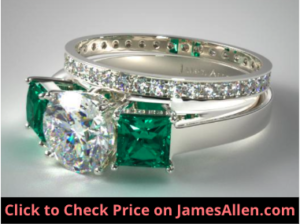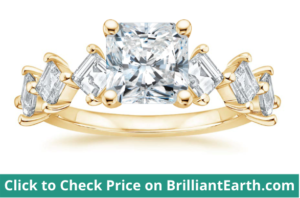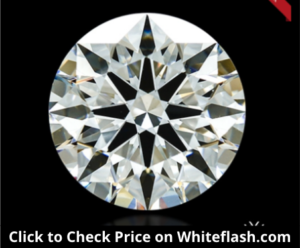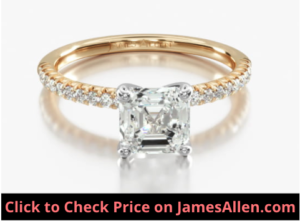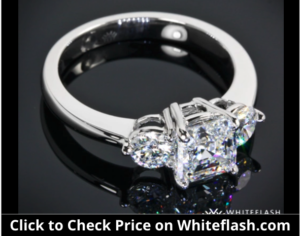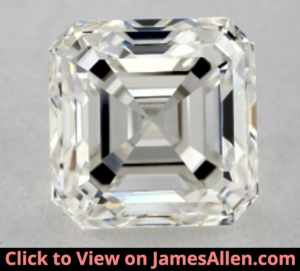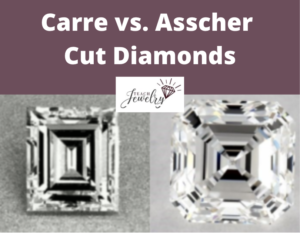
Two types of diamonds that are less popular than others, but can still serve as the center diamond in an engagement ring, are Carre and Asscher cuts.
Asscher and Carre cuts may look similar at first glance, but the difference is that Asscher cuts have beveled corners, which gives them eight sides. Carre cuts have four sharp corners. Both lack the brilliance you’d expect to find in a diamond ring but instead display a soft glow.
We’ll compare Carre versus Asscher cut diamonds, including an overview of each, their pros and cons, and how you should decide which cut is best for you.
What is a Carre Cut?
Carre cut diamonds are square step cuts that features four sharp corners. Their facets resemble the style of other step cuts such as baguette and emerald cuts, but its overall shape mimics a princess cut diamond.
Check out the image below of a Carre cut diamond set with pavé.
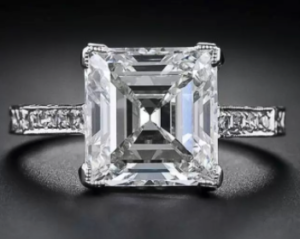
Instead of the triangle- or kite-shaped facets found in brilliant cuts, they imitate a set of stairs cascading toward its center.
These open, long facets allow viewers to see farther inside the stone. In the face-up view above, notice how some of the facets run horizontal across the stone, and others are vertical.
It creates a vintage-style diamond that contrasts with the popular modern styles.
To continue with this theme, you can place Carre cuts in settings that feature antique designs such as milgrain beads around the shank.
Carre cuts are the least popular step-cut diamond because most buyers who want a square-shaped diamond opt for the brilliance of a princess cut or the elegance of an Asscher cut.
That being said, Carre cuts can be right for someone who prefers a subdued sparkle over flashy brilliance and sharp corners instead of beveled edges.
Pros
Strong Fire
Carre cuts display strong fire because of their elongated facets. Fire refers to the flashes of colored light that radiate from a diamond.
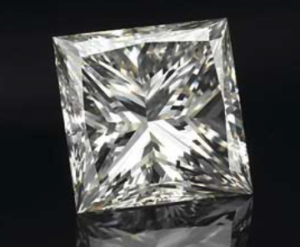
Light enters the diamond and is then reflected out at different rates, which creates red, yellow, blue, and orange lights. This is in contrast to brilliance, which is the white light that radiates from brilliant cuts.
If your Carre cut has excellent polish and symmetry and is placed under LED lights, it’ll display high amounts of fire.
Low Cost-Per-Carat
Carre cuts also have a lower cost-per-carat than brilliant cuts and many step cuts. There are two reasons they sell for a lower price.
The first reason is there is lower demand for Carre cuts. Diamond retailers can’t charge as high of a price for them as they can for Asscher, round, princess, and marquise cuts.
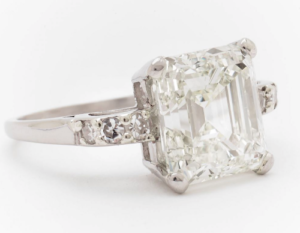
Secondly, Carre cuts don’t result in wasting as much of the original diamond. In fact, they use between 60-65 percent of the rough diamond, while round cuts use between 45-51 percent of it.
If you’re looking for a diamond where you can choose a heavier weight without the significant cost, a Carre cut may be right for you.
Alternative to Popular Cuts
They also offer an alternative to the most popular cuts for engagement rings.
The most common styles are round, princess, and marquise cuts diamonds, but some buyers want to avoid them and instead choose one that’s unique.
It’s rare to see Carre cuts as the center diamond, so it meets that criteria.
But you don’t have to place one as the main gem in an engagement ring. For example, here’s a platinum three-stone ring where two Carre cuts surround a round cut.
They stand out because of their color even though the round cut will produce the most light return.
Cons
Fewer Options Available
Because they aren’t as popular as other cuts, there are fewer options available from diamond sellers.
Many major retailers such as James Allen and Blue Nile don’t sell them as loose diamonds. The only options are ones already placed in other pieces of jewelry.
To illustrate, here’s a ring with eight Carre cuts placed in 18K yellow gold.
The center gem is the most prominent. It’s surrounded by three of the same cuts on either side, but each is smaller than the one in the middle.
Lack Brilliance
Carre cuts also have less brilliance than other cuts. Their facets aren’t designed to maximize how much light is collected and returned, so it’ll appear dull compared to many brilliant cuts.
The large, elongated facets leak light and instead produce a subtle glimmer. You can identify the size of facets on Carre cuts in this image.
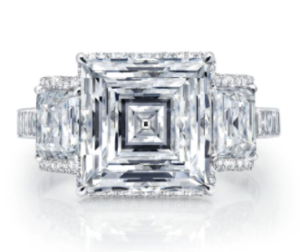
Now compare them to the size of facets on this round cut.
Brilliance is a valued trait for an engagement ring diamond, which is why buyers often opt for those over Carre cuts.
Susceptible to Chips
Another disadvantage of Carre versus Asscher cuts is their sharp corners leave them vulnerable to chipping.
If one of its four corners experiences a hard impact, or the diamond is dropped, it’s more likely to break than a rounded or straight edge.
Protect the corners of Carre cuts with a strong setting, whether a prong on each corner or a bezel around its edges.
Avoid choosing one with inclusions in those susceptible areas because they often represent a weak point in its structure.
Doesn’t Hide Inclusions or Color
The lack of brilliance in a Carre cut, and its large, deep facets, mean it shows inclusions and color more than brilliant cuts.
The flaws inside a diamond aren’t hidden by white light, so twinning wisps, feathers, and other blemishes are more noticeable.
You’ll also have to choose a higher color grade for it to appear colorless to the naked eye. Instead of an I or J color grade from the GIA, we recommend you start your search with an H or G color grade if you want a Carre cut that appears colorless.
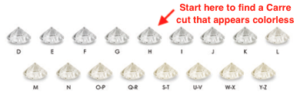
On the clarity scale, start your search at SI1, but you may have to move to VS2 or VS1 to find one that appears eye-clean.
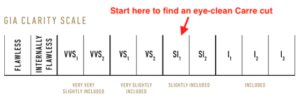
You’ll avoid the premiums charged for the highest grade, but it can look identical.
What is an Asscher Cut?
Asscher cut diamonds have a square shape with 58 step-cut facets.
A unique feature is its cropped corners, which give it eight total sides. Four of its edges are much shorter than the others.
You can identify these features in the image below of an Asscher cut diamond ring.
Its stair-like facets have a layered look referred to as a “hall of mirrors.” When viewed from the top-down, it has the appearance of a windmill.
Asscher cuts were invented in the early 1900s by the Asscher brothers. It wasn’t until the 2000s that they became more popular as engagement ring diamonds, known for a vintage style and high crown.
When they’re used in engagement rings, Asscher cuts are often the center diamond, as opposed to smaller accents placed along the shank.
Instead, round cuts are often used to surround Asscher cuts, like in the example below, because they compensate for its lack of brilliance.
An alternative to the traditional Asscher cut is the Royal Asscher diamond. It has 74 facets, a deep pavilion, and is considered the first patented diamond cut.
Pros
Durable
Cropped corners result in more durability compared to Carre cuts.
Sharp corners are the most vulnerable places on most diamonds, but the beveled edges on an Asscher cut provide its corners extra strength.
If the diamond is dropped or struck against a surface, it’s less likely to break, especially with a strong setting.
Affordable
Asscher cuts also have a lower cost-per-carat compared to other cuts.
I analyzed prices of 193 diamonds from Blue Nile with the following grades from the GIA:
- Carat weight: 1.00
- Cut: Very good
- Clarity: VS1
- Color: G
For round cuts, prices ranged from $4,864-$8,116.
Asscher cuts were priced between $3,309 and $6,076.
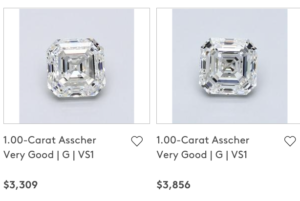
That puts the average price of round cuts with those qualities at $6,490. For Asscher cuts, it’s $4,693.
The result is a 38 percent premium for round over Asscher.
Variety of Shapes
Another advantage of Asscher cuts is they come in a variety of length to width ratios.
The traditional ratio is 1.00, but anything between 1.00-1.05 will appear as a square to the naked eye.
Stick within this range for an ideal cut, but if you prefer a rectangular shape, there are variations with a length to width ratio of more than 1.05.
Cons
Poor Brilliance
Its step-cut facets exhibit low brilliance because they aren’t designed to collect and reflect light.
It produces a much more subtle glow compared to brilliant cuts and is instead comparable to a Carre cut.
It’s why they account for less than one percent of engagement ring diamonds.
Instead, they can be used in antique settings that aren’t meant to highlight sparkle.
Shows Flaws and Yellow Tints
A lack of brilliance also means inclusions are more visible. The large facets provide a window into blemishes that are more noticeable to the naked eye.
While brilliant cuts can be eye-clean with an SI1 clarity grade, you may have to choose a VS2 clarity grade or higher for an Asscher cut to have the same effect.
The same principle applies to color. While some buyers prefer a soft yellow glow in Asscher cuts, you’ll likely have to choose a H color grade or higher for it to appear colorless.
The Asscher cut below earned a J color grade from the GIA.
The hints of yellow are obvious in that high-resolution image, but they’d also likely be noticeable when viewed in a normal setting.
No GIA Cut Grade
The GIA also doesn’t grade the cut quality of Asscher diamonds or other fancy shapes.
The extensive number of shapes of these diamonds has kept the GIA from developing a consistent grading system.
You’ll have to rely on other measurements such as its depth, symmetry, polish, and length to width ratio in order to know whether it’s a quality cut.
Take the time to understand each of these qualities because cut is the most important factor in a diamond’s overall performance.
How to Decide Between Asscher and Carre Cuts
The decision between a Carre versus Asscher cut diamond involves understanding the primary traits of each and which qualities are important to you.
Here are some tips to help you decide between them.
A Carre cut may be right for you if:
- You’re looking for a step-cut diamond with fire
- You want a low cost-per-carat
- It’s important to you that your diamond is a unique cut not found on many other rings
- You’re willing to protect its sharp corners with a strong setting
You should consider an Asscher cut if:
- You’re looking for a durable step-cut diamond
- You want a diamond with a lower cost-per-carat than brilliant cuts
- You aren’t concerned about brilliance and fire in your diamond
- It’s vintage aesthetic is appealing to you
Explore examples of both cuts so you can view how they fit in different types of settings.
You may prefer a solitaire setting that focuses on the center diamond, or you could embellish the ring with pave or accents.
Whether you choose an Asscher or Carre cut, you can build the perfect ring for your style.

Jacob Clarke
Jacob Clarke is the founder of TeachJewelry.com.
He earned an Applied Jewelry Professional Diploma from the Gemological Institute of America (GIA) and now brings you essential information about diamonds, settings, and more.
Jacob has consulted with leading jewelry brands, and his work has been cited in Clean Origin, Diamond Nexus and industry publications.
He's also a member of the International Gem Society.
He enjoys discussing jewelry with readers, so contact him with any questions at jacob.clarke@teachjewelry.com.

